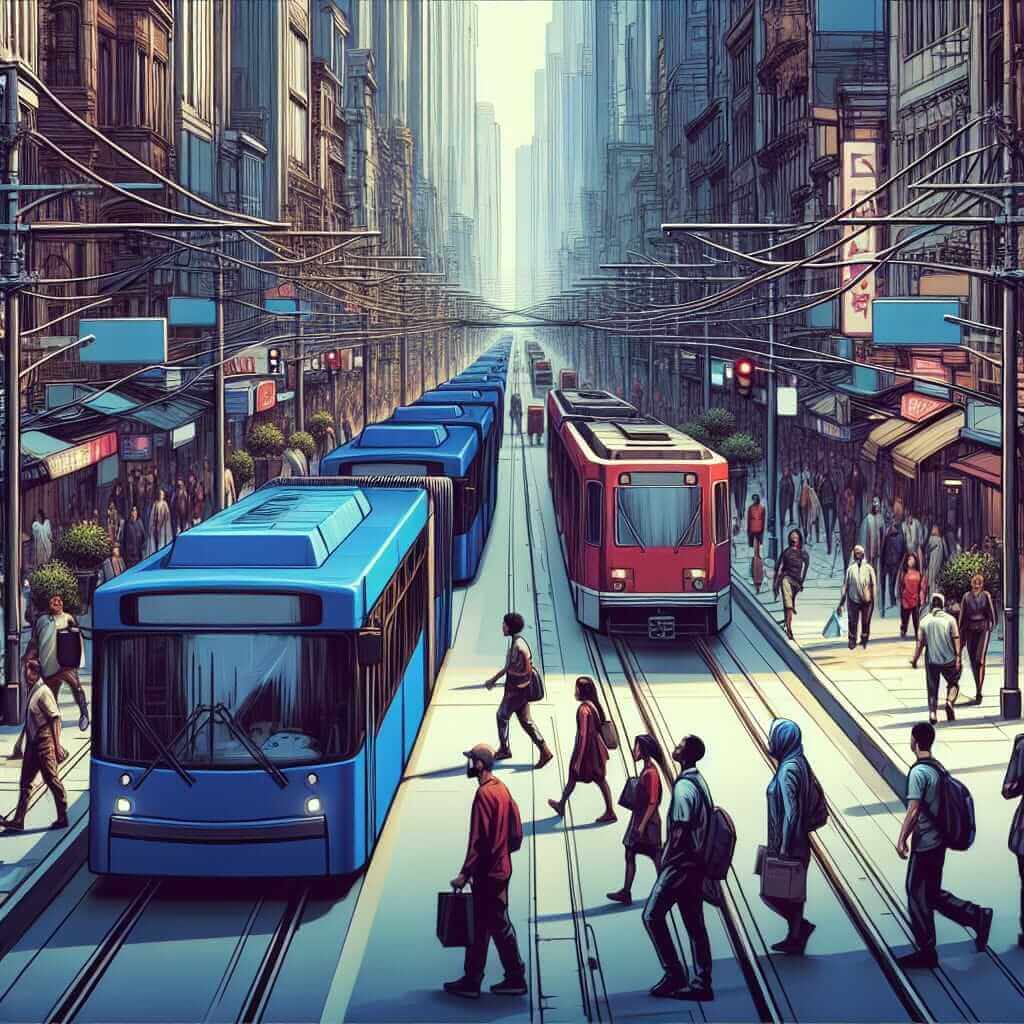Public transportation has become a focal point in discussions about urban planning and environmental sustainability. This topic frequently appears in IELTS Writing Task 2, challenging candidates to analyze and argue its importance. This article will delve into the significance of public transportation in reducing traffic congestion, incorporating various LSI keywords and SEO best practices to provide a comprehensive learning resource for IELTS students.
IELTS Writing Task 2 Prompts on Public Transportation
- Some people believe that increasing public transportation is the best solution to traffic congestion in cities. To what extent do you agree or disagree?
- Discuss the advantages and disadvantages of public transportation in urban areas.
- Many cities around the world face severe traffic congestion. How can public transportation help to reduce this problem? Give reasons for your answer and include any relevant examples from your own knowledge or experience.
Chosen Prompt
For this article, we will focus on the first prompt: Some people believe that increasing public transportation is the best solution to traffic congestion in cities. To what extent do you agree or disagree?
Analyzing the Prompt
This prompt is a partial agreement question which requires evaluating the effectiveness of public transportation in solving traffic congestion issues in urban areas. The candidate should discuss both the potential benefits and limitations and then provide a balanced viewpoint.
Sample Essay: The Role of Public Transportation in Mitigating Traffic Congestion
Introduction
Traffic congestion is a pressing issue in numerous urban areas globally, leading to increased pollution, wasted time, and heightened stress levels among commuters. While some argue that enhancing public transport facilities is the key solution to this predicament, others suggest that this might not be sufficient. This essay will discuss both perspectives to determine whether public transportation is indeed the optimum solution for urban traffic congestion.
Advantages of Public Transportation
Public transportation offers several benefits that make it an attractive option for mitigating traffic congestion. Firstly, it can significantly reduce the number of private vehicles on the roads. For instance, a single bus can carry dozens of passengers, which would otherwise translate to a comparable number of cars on the streets. This not only eases congestion but also decreases urban pollution levels.
Moreover, public transportation is often more efficient in terms of space utilization. Subways and trams, for example, can transport large numbers of people without occupying as much road space as cars or motorcycles would. This efficient use of space is crucial in densely populated urban areas.

Additionally, enhanced public transport systems can lead to a shift in commuter preference. Reliable and convenient public transportation can encourage more individuals to leave their cars at home, further contributing to reduced road congestion. Cities like Tokyo and London are stellar examples where extensive public transport networks have successfully mitigated traffic woes.
Limitations of Public Transportation
Despite these advantages, there are certain limitations to relying solely on public transportation to resolve traffic congestion. First, the initial cost of developing and maintaining comprehensive public transport systems can be enormous. Many cities in developing countries struggle with the financial burden required to establish these networks.
Secondly, public transportation may not always be accessible or convenient for all citizens. In sprawling urban areas, the last-mile connectivity remains a critical issue, making it difficult for some to rely exclusively on public transport. This limitation can decrease the overall efficacy of such systems in reducing traffic congestion.
Furthermore, public transportation solutions may not address other factors contributing to traffic problems, such as inefficient traffic management or a lack of alternative commuting options like cycling lanes.
Conclusion
In conclusion, while public transportation plays a vital role in alleviating traffic congestion, it is not a panacea. The benefits of reduced vehicular presence and efficient space utilization are significant, but they must be weighed against the challenges of financing and accessibility. Therefore, while cities should invest in and expand public transport networks, they should also consider integrating other solutions such as better traffic management systems and promoting sustainable commuting alternatives to comprehensively tackle traffic congestion.
Word Count: 392
Key Considerations for IELTS Writing Task 2 on Public Transportation
Vocabulary and Grammar Notes
- Utilize complex sentences: Incorporate a mix of simple, compound, and complex sentences to demonstrate command over different sentence structures.
- Use topic-specific vocabulary: Words such as “mitigate,” “efficacy,” “urban pollution,” and “vehicular presence” are relevant to the topic and showcase a strong vocabulary range.
- Examples and evidence: Support statements with real-world examples or hypothetical scenarios to strengthen arguments.
Vocabulary to Remember
- Mitigate (verb) /ˈmɪtɪɡeɪt/: To make something less severe or serious.
- Efficient (adjective) /ɪˈfɪʃ(ə)nt/: Being effective without wasting time or resources.
- Congestion (noun) /kənˈdʒɛstʃən/: Overcrowding, especially in terms of traffic or population.
- Utilization (noun) /ˌjuːtɪlaɪˈzeɪʃən/: The act of using something efficiently.
- Comprehensive (adjective) /ˌkɒmprɪˈhɛnsɪv/: Including all or nearly all elements or aspects of something.
- Panacea (noun) /ˌpænəˈsɪə/: A solution or remedy for all difficulties or diseases.
- Sustainable (adjective) /səˈsteɪnəb(ə)l/: Capable of being maintained over the long term without harming the environment.
Conclusion
In tackling IELTS Writing Task 2 topics related to public transportation and traffic congestion, it is essential to present a balanced view, incorporating a wide range of vocabulary, and supporting arguments with relevant examples. Remember, practice makes perfect; hence, attempt writing essays on related topics such as “The Impact of Public Transportation on Urban Development” and “The Importance of Public Transport in Reducing Urban Congestion” to further hone your writing skills.
For more tips and structures about IELTS Writing, visit our writing structure guide.